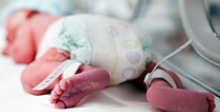Internal mini form
Contact Us Today
Forceps and vacuum extractors are medical devices commonly used to assist in the delivery of babies. Properly used these devices can help doctors to safely deliver babies. However they can also lead to mechanical injury trauma to the baby.
How does traumatic brain damage occur?
Doctors use medical devices to assist in the delivery of babies. Two types of devices for this purpose are forceps and the vacuum extractors. Forceps, which resemble common salad tongs, grip around the head of a baby in order to assist delivery through the birth canal. If the forceps are gripped too tightly, or if the baby’s head is twisted in the wrong direction, the infant can sustain serious injury, including a compression injury to the brain.
In a vacuum assisted delivery, a soft plastic cup is attached to the top of the baby’s head. Gentle vacuum pressure is applied, permitting the obstetrician to rotate or otherwise adjust the baby to allow for safe delivery.
Properly used, these devices can help doctors to safely deliver babies. However, these devices can also cause mechanical injury trauma to the baby’s skull, face and brain. Obstetricians must be cautious in applying these devices and then by physical force, pulling on a baby’s head with a vacuum extractor or forceps. If placed incorrectly, applied with excessive traction or pressure, or if the obstetrician pulls excessively, the baby’s brain can be severely injured. Used incorrectly, these devices can severely damage the brain, causing bleeding, and may result in Cerebral Palsy.
If injured by either of these powerful devices, the baby at birth may initially seem quite normal, but may then demonstrate difficulty breathing, turn blue, or exhibit seizure activity and other neurological symptoms. These babies will typically require ultrasound, CT scans or MRIs, to evaluate the extent of the injury to the brain.
While Cerebral Palsy is a common result of birth injury, other injuries frequently occur, as well.
Some common birth injuries that can occur following a traumatic delivery assisted by forceps or a vacuum extraction device include:
Erb’s Palsy – A condition of the shoulder that limits arm movement and sensation. Also sometimes referred to as Brachial Plexus Palsy, Erb’s Palsy typically damages the nerves that control the muscles in the hand and arm.
Shoulder Dystocia – An abnormal presentation of the baby at delivery that can result in injury to the infant’s nerves, tendons, and muscles. In this condition, the baby requires manipulation to permit delivery. If caught in the birth canal, the delivering obstetrician might pull too aggressively, causing injury that may result in Cerebral Palsy or other neurologic injury.
Brachial Plexus Palsy – A disabling condition to a nerve junction that can result in arm movement and sensation difficulties. Brachial plexus palsy is caused by damage to the brachial plexus. An injury results from excessive or improper pressure on the shoulder during delivery, which in turn damages the brachial plexus.
Klumpke’s Palsy – A variety of Brachial Plexus Palsy that injures the fingers and wrist. This can occur during delivery in association with a shoulder dystocia
Were you or your child at risk – before, during or after your child’s birth?
Cerebral Palsy risk factors are events, substances or circumstances that increase the chances of a child developing Cerebral Palsy. They can be avoidable, or unavoidable. A risk factor does not ensure a child will develop Cerebral Palsy; it means chances are higher than if that risk factor was not present. Likewise, the absence of risk factors does not ensure that a child will not develop Cerebral Palsy. Have you been exposed to the following risk factors?
- Cerebral Palsy Risk Factors
Types of risk factors:
- Asphyxia and oxygen deprivation
- Blood type incompatibility or jaundice
- Complications of birth
- Infection
- Intrauterine growth restrictions
- Multiple births and infertility drugs
- Parental health and habits
- Placenta complications
- Premature birth
- Traumatic brain damage
Risk factors vs. risk factor causal pathways
A risk factor does not ensure a child will develop Cerebral Palsy; it means chances are higher than if that risk factor was not present. Likewise, the absence of risk factors does not ensure that a child will not develop Cerebral Palsy.
- Risk Factors and Risk Factor Causal Pathways
The Cerebral Palsy Risk Factor Checklist
Any exposure to risk factors prior to conception and during pregnancy should be immediately discussed with a doctor in order to treat and minimize risk. The Cerebral Palsy Risk Factor Checklist helps parents determine if they may have been exposed to risk factors for Cerebral Palsy.
- The Cerebral Palsy Risk Factor Checklist









